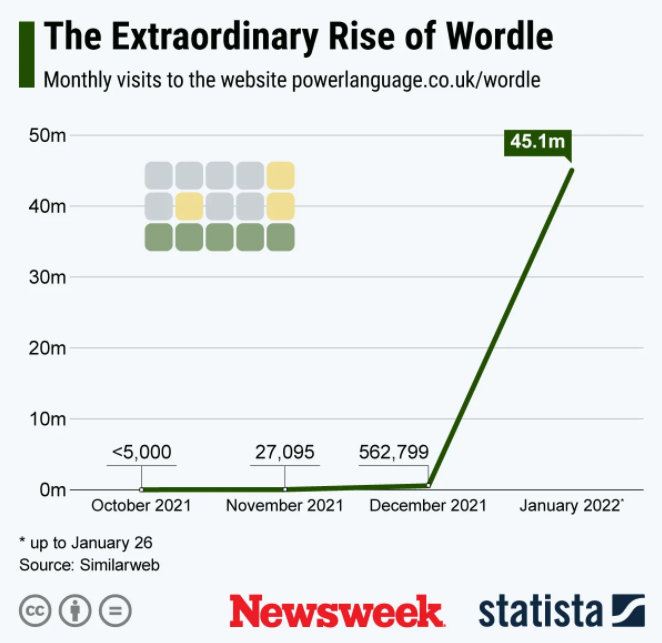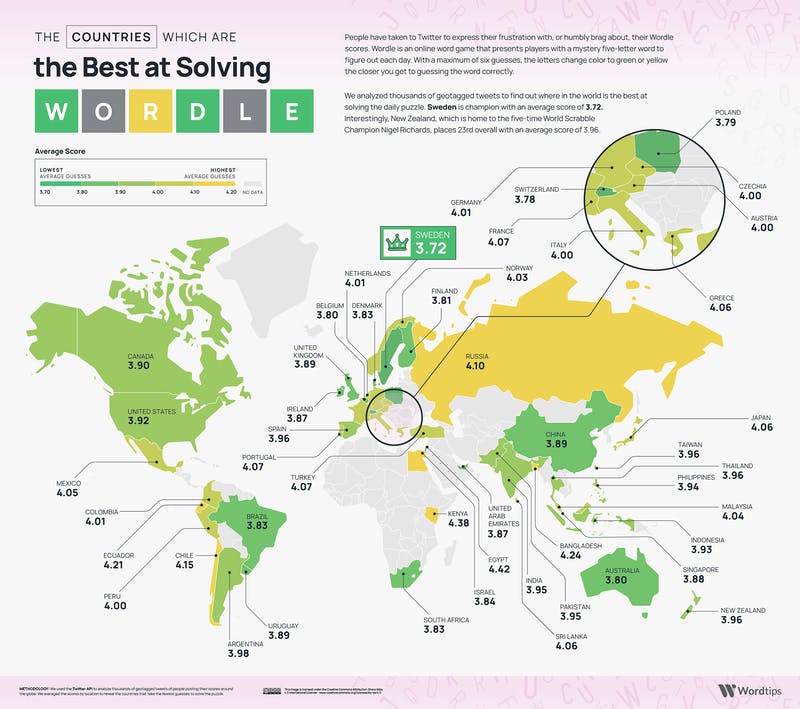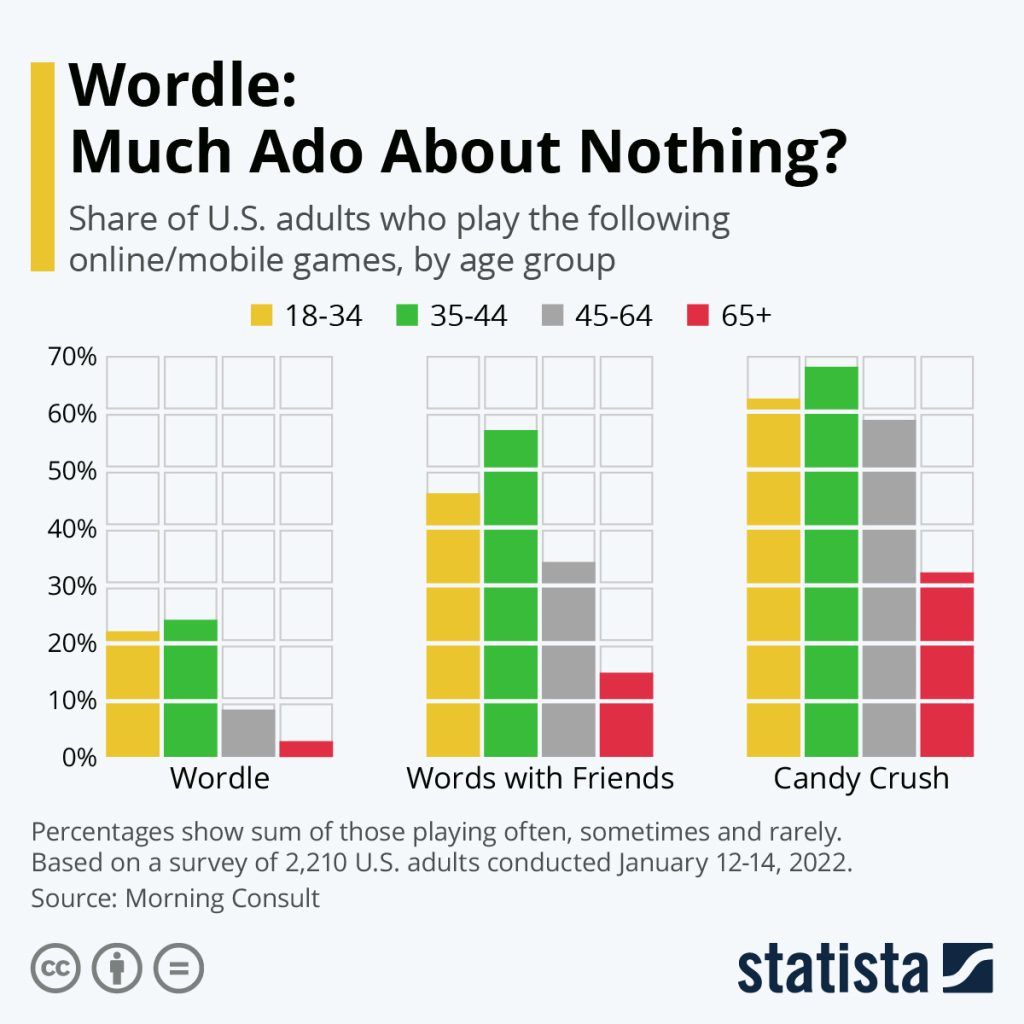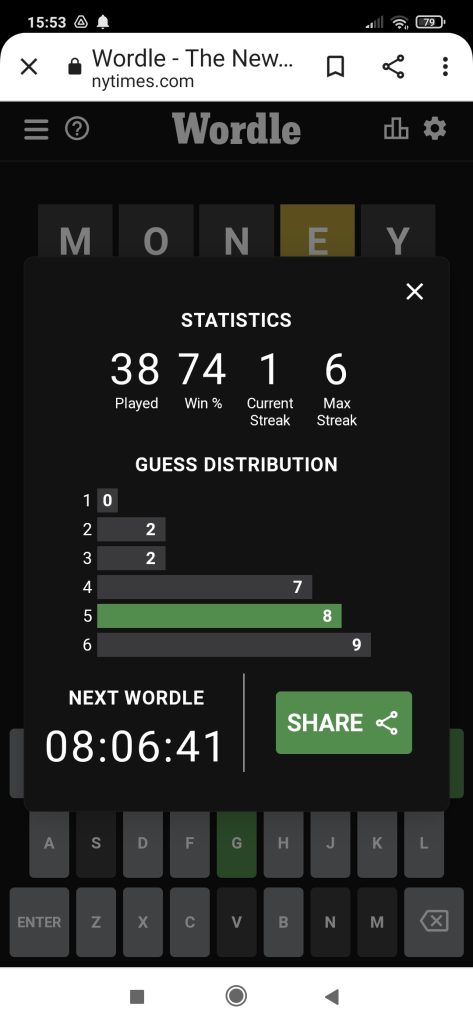Wordle: 5 takeaways to improve your marketing strategy
I glance rapidly at the phone: eight more hours to go before I can play again. I refrain from looking for five-letter words online, I want to discover the next word by myself with no additional help. That’s the whole point of the game, to challenge oneself and work the brain. And when I guess the word, it’s twice as satisfying since English is not my first language.
What is this game? It’s Wordle.
Wordle was created by Josh Wardle (notice the pun: wardle – wordle), a software engineer with a passion for games, as a word game for the enjoyment of him and his partner.
He released the game to the public in October 2021 and saw it going from 90 players to 45 million players in the first week of January 2022.
New York Times acquired Wordle on 31 January 2022 when Josh felt the game, with its overnight success, began to be too much for him to manage.
About Wordle: game rules and statistics
- The game challenges users to guess a hidden five-letter word in six tries or less
- The game resets once a day so users have 24 hours to guess the word
- It’s the same word for everyone
- No login, therefore, no user data
- Free to play, no ads
- Launched to the public in October 2021
- Grew from 90 users/day to 45 million users on Jan 26, 2022
- Sold to New York Times on Jan 31, 2022
- 1.7 million mentions on Twitter in the first two months
- Sweden is the world’s best country at Wordle, with the fastest rate at solving the puzzle as per this report
- Millennials love Wordle: people between the ages of 35-44 make up the bulk of the game’s players per Statista.



Can marketers learn from Wordle’s success?
Yes, and I boiled down the reasons why Wordle has become such a global hit and came up with 5 takeaways that marketers can apply to build virality into their campaigns.
Let’s break them down!
1. Wordle has the right amount of challenge
I like playing games like anyone else. I remember playing Space Invaders and GTA fifteen years ago. They were challenging in that they required quick responses and challenged my eye to hand coordination. I played two-three times and quickly lost interest.
On the other side of the spectrum, you have deep thinking games like chess. Although I loved The Queen’s Gambit, and have played chess once or twice, it’s too challenging for me. It requires resources I don’t have among which a lot of patience which apparently I lack.
Wordle is the right amount of challenging: not too easy, not too hard.
The secret lies in the game’s ingenious mechanism: the rules are so that the player doesn’t get discouraged. The game tells you You are correct, there is an E in the word, but it’s not here, find the right place inside the word. With every correct letter and correct location of the letter inside the hidden word, you are gently nudged toward solving the puzzle.
WORDLE MARKETING TAKEAWAY #1
Design your campaign with the right amount of built-in challenging features.
Find ways to encourage and reward your audience at every stage of the campaign. This will keep your audience engaged and wanting more.
2. Wordle’s scarcity feature increases engagement on a global scale
The game is built in 24-hour sessions within which you can play one word only. No matter where you are in the world, one word.
Scarcity is one of Cialdini’s 7 Principles of Influence and Persuasion:
- Reciprocity
- Commitment and Consistency
- Liking
- Scarcity
- Authority
- Social Proof
- Unity
Also known as The Godfather of Influence, Dr Cialdini is the most cited living social psychologist in the world and a past speaker at BRAND MINDS.
The scarcity principle states that when something is in short supply, we perceive it as more valuable thus fuelling our desire to have it.
In the game’s case, scarcity is present but works differently. Because it’s the same word for everyone, the game sparks discussions on a global scale. New Zealanders, Austrians, Canadians, Bulgarians – people from different timezones, cultures and languages come together to talk about one thing – the word of the day in Wordle.
WORDLE MARKETING TAKEAWAY #2
Whether your campaign features a one-time deal or a limited number of products, leverage the scarcity principle to prompt your customers to take action.
If you can think of a way to have your audience talk about your product or a specific topic your product refers to, you have increased chances to see brand conversations skyrocket.
3. Wordle has built anticipation within the game’s mechanism
What do I do next after solving the day’s puzzle? I look forward to the next puzzle counting the hours until the game resets. Ten minutes before the reset, I open the game and literally stare at the timer counting the seconds until I can work on a new word. That’s excitement and anticipation.
There’s been a lot of talk over the past few years about how brands and commerce, in general, have lost anticipation as a way to engage with customers all due to the instant satisfaction demands from the younger generation.
Amazon brings in billions of dollars in profit with its one-day delivery service. Big retail chains are now providing customers located within a specific radius with a one-hour delivery service.
Depending on the industry, building buzz is something marketers are looking to achieve through savvy marketing, social media and PR campaigns.
If you’re in the events industry, you build buzz and create anticipation with new speaker announcements. If you’re in retail, the fastest delivery wins customers and revenue.
Or if you’re Beyonce, you skip anticipation entirely and just drop the newest album on your fans and replace anticipation with frenzy, as highlighted by Branding Expert Martin Lindstrom here.
WORDLE MARKETING TAKEAWAY #3
Launching a new product or service? Unless you have the clout of Queen Bey, you need to build anticipation.
Brainstorm ways to create buzz on social media and have your customers waiting in anticipation for your new event. Of course, it’s useful to have an engaged community so building one should be your number one priority before anything else.
4. Wordle’s sharing feature is a great referral program
After solving every puzzle, users can check their game statistics and see how their skills have improved with each game. They can also share a screenshot of their just-finished game on social media and messaging apps. In doing so, users showcase their Wordle skills and can also see how they compare with other players. The letters are hidden so players who haven’t played the world of the day yet are not robbed of their chance to guess it.
The sharing feature accomplishes two goals: users get to show off their skills and the game extends its reach organically.

It’s what Spotify did in 2016 when it integrated with Facebook Messenger allowing users to share their Spotify songs or playlists directly within a chatbox. This integration accelerated Spotify’s growth through referral traffic with millions of Facebook users joining Spotify.
Airbnb’s integration with the Craiglist platform is now the company’s most famous growth hack. In 2010, looking to access Craiglist’s huge user base, Airbnb built a bot to piggyback the platform. Discover 10 Growth Marketing Tactics To Grow Your Business.
WORDLE MARKETING TAKEAWAY #4
Today’s digital environment makes it very easy for marketers to spread the word about products and services. The challenge marketers face is not technical: if it’s digital, it can be shared.
What marketers need to do to reach new customers beyond brand digital assets is give them reasons to talk about the brand.
If your product delivers more than what the customer expected, they will share it on social organically.
If your brand set out to manage the sharing process, build a referral program where you decide the what, the how and the why.
- What do customers get for sharing your product?
- What is the mechanism of sharing?
- What are new customers offered?
- How simple/complex is it for customers to share your product?
5. Wordle is leveraging the power of social proof
I learned about Wordle when someone shared their stats on Facebook. I didn’t understand what it was at first. I only saw a mysterious white square with green, yellow and grey small tiles. More posts began popping up in my feed from people I knew so I decided to find out what this game was. The shared post didn’t have a link back to the game so I had to look it up on Google. I ended up on the game’s initial website, powerlanguage.co.uk/wordle, and began playing. The game had just earned a new player through the power of social proof.
Social proof is one of Cialdini’s 7 principles of influence and persuasion (you read about scarcity at Takeaway #2).
The social proof principle states that people will look to the actions of others to determine their own.
WORDLE MARKETING TAKEAWAY #5
According to a report by Sprout Social, friends are the ultimate influencers for consumers aged 18-40, with influencers as a close second.
So to get to new customers, marketers need to get their message shared by their existing customers first.
What do marketers need to do to achieve this goal? Begin with the end in mind.
What should the copy write so the social post gets shared?
What should the ad look like so it grabs the customer’s attention?